

Dragons in Buddhism, Hinduism and Tibetan beliefs. “Five Dragons”artist: © Mariusz Szmerdt artwork details: type of painting: ink painting background color: rice white size: 206x46cm / 81″x18″ artist’s signature: hanko (artist’s seal)*** materials used: black ink, water, brushes, paper, organic glue (のnori) type of paper: ink painting paper urauchi** work backing: yes Category: Five DragonsProduct ID: S047Price: 950USDproduct available Stars: 4.9 based on 9< ratings In Tibetan mythology, dragon is a mighty creature, blessed with unbound creative powers.

Tide jewels. Terminology[edit] Early references[edit] Two Nara period (710-794 CE) historical texts record myths that the Sea God presented the kanju and manju to Hoori, and a Kamakura period (1192-1333 CE) text says the legendary Empress Jingū used the tide jewels to conquer a Korean kingdom in 200 CE.

The tide jewels are central to "The Lost Fishhook" legend about the fisherman Hoderi and hunter Hoori, two brothers who argued over replacing a lost fishhook. Hoori went searching to the bottom of the sea, where he met and married Toyotama-hime, the daughter of the dragon Sea God. After living three years in the undersea Ryūgū-jō 竜宮城 "dragon palace castle", Ryūjin presented Hoori with his brother's fishhook and the tide jewels, and arranged for him to take his sea-dragon bride back to land. Kojiki[edit] The ca. 680 CE Kojiki 古事記 "Record of Ancient Matters" uses the archaic names shiomitsu-tama 潮満珠 "tide-flowing jewel" and shiohiru-tama 潮干珠 "tide-ebbing jewel" in two consecutive passages. Nihongi[edit] Dragons, Dragon Art, and Dragon Lore in Japan, Buddhism & Shintoism Photo Dictionary.
Www.khandro.net Much has been made of these distinguishing characteristics among Asian dragons.
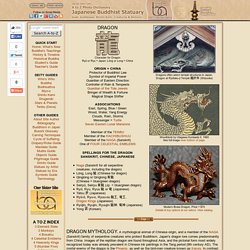
There is an iconographic convention in which the common dragon has only four claws. Dragons, Dragon Art, and Dragon Lore in Japan, Buddhism & Shintoism Photo Dictionary. Www.khandro.net Much has been made of these distinguishing characteristics among Asian dragons.
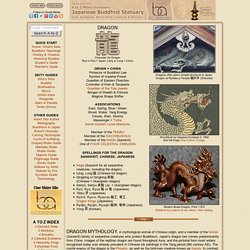
There is an iconographic convention in which the common dragon has only four claws. The five-clawed dragon, in contrast, is reserved for the Chinese imperial family, while the colonial type (such as the Japanese dragon) has only three claws. Another View of Claws, From WikipediaChinese or Korean imperial dragons have five toes on each foot; Indonesian dragons have four and Japanese dragons have three. Dragon - Chinese Buddhist Encyclopedia. A dragon is a legendary creature, typically with serpentine or reptilian traits, that features in the myths of many cultures.
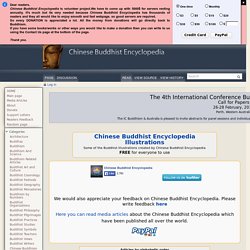
There are two distinct cultural traditions of dragons: the European dragon, derived from European folk traditions and ultimately related to Greek and Middle Eastern mythologies, and the Chinese dragon, with counterparts in Japan, Korea and other East Asian countries. The two traditions may have evolved separately, but have influenced each other to a certain extent, particularly with the cross-cultural contact of recent centuries. The English word "dragon" derives from Greek δράκων (drákōn), "dragon, serpent of huge size, water-snake". Name. Buddhist Symbols and Iconography. Japanese dragon. Emperor Antoku's grandmother rescuing him from a dragon, by Yoshitsuya Ichieisai.

Indigenous Japanese dragons[edit] The ca. 680 AD Kojiki and the ca. 720 AD Nihongi mytho-histories have the first Japanese textual references to dragons. "In the oldest annals the dragons are mentioned in various ways," explains de Visser (1913:135), "but mostly as water-gods, serpent- or dragon-shaped. " The Kojiki and Nihongi mention several ancient dragons: These myths about Emperor Jimmu descending from Toyatama-hime evidence the folklore that Japanese Emperors are descendants of dragons.
Dragons in later Japanese folklore were influenced by Chinese and Indian myths. Sino-Japanese dragons[edit] Chinese dragon mythology is central to Japanese dragons. Japanese Shiryū 四竜 "4 dragon [kings]" are the legendary Chinese Longwang 龍王 "Dragon Kings" who rule the four seas. Some authors differentiate Japanese ryū and Chinese long dragons by the number of claws on their feet. Indo-Japanese dragons[edit] Images[edit] Symbols of Tibetan Buddhism. Tibetan Buddhist Symbols Tibet is a vast country, spread out between India and the Himalayas in the South, and China in the east.
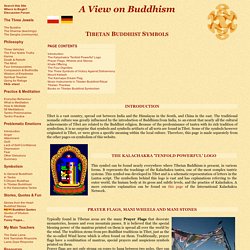
The traditional nomadic culture was greatly influenced by the introduction of Buddhism from India, to an extent that nearly all the cultural achievements of Tibet are related to the Buddhist religion. Because of the predominance of tantra with its rich tradition of symbolism, it is no surprise that symbols and symbolic artifacts of all sorts are found in Tibet. Some of the symbols however originated in Tibet, or were given a specific meaning within the local culture. Therefore, this page is made separately from the other pages on symbolism of this website. Typically found in Tibetan areas are the many Prayer Flags that decorate monasteries, houses and even mountain passes. The Wind Horse (Tib. "The traditional Wind Horse Prayer Flags are ancient designs.
Prayer Wheels are another typical Tibetan phenomena. Dragons in Buddhist Mythology, Art, and Literature. Dragons have been part of Chinese culture for at least 7,000 years.
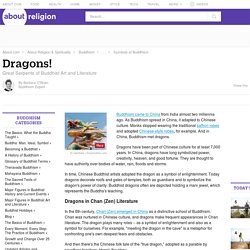
In China, dragons have long symbolized power, creativity, heaven, and good fortune. They are thought to have authority over bodies of water, rain, floods and storms. In time, Chinese Buddhist artists adopted the dragon as a symbol of enlightenment. Today dragons decorate roofs and gates of temples, both as guardians and to symbolize the dragon's power of clarity. Buddhist dragons often are depicted holding a mani jewel, which represents the Buddha's teaching.